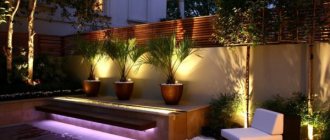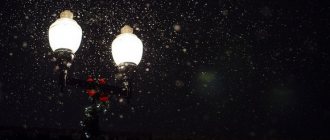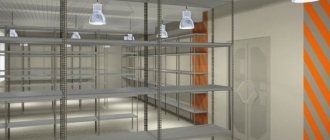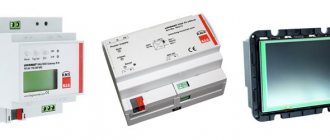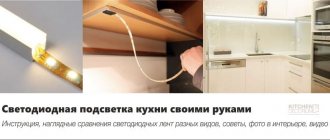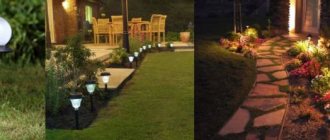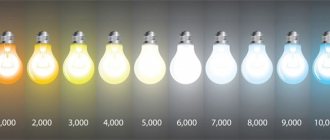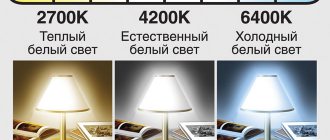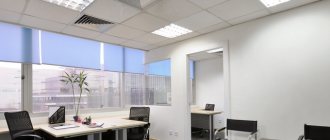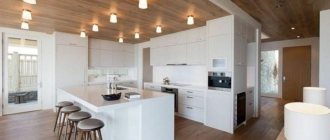Many factors in human life depend on light, the main one being comfort and coziness. The sun cannot illuminate the streets around the clock, so how can you feel safe? For this purpose, there is external lighting, thanks to which everyone can navigate the space. Also, do not forget about the beauty of the landscape, which is emphasized by a properly installed outdoor lighting system.
Outdoor lighting has several main types and many nuances. This should include not only technical, but also architectural solutions. Interior lighting helps us navigate indoors; this is also an important component of a comfortable life. This includes not only private houses and apartments, but also factories and industrial enterprises. Outdoor lighting is an important part of our lives and this material will tell you about it.
Types of Outdoor Lighting
Decorative lighting
This type of lighting is necessary to create special architectural solutions. Typically used in the design of parks, various city and public places, as well as private homes. This method illuminates buildings, bridges, squares, advertising stands and lampposts. If everything is done correctly, then a simple area can turn into a real fairy tale.
Outdoor LED lighting has a special place here. After all, LEDs are considered the most expensive and high-quality source. And this is true, such lamps can work for more than ten years, they do not produce a dull yellow flicker, but bright streams of white color. The placement of LEDs on the streets is one of the main tricks of decorative lighting. Unfortunately, such lamps are usually used in private enterprises and homes. The streets are illuminated with something simpler and cheaper.
The main trick to decorative lighting is the correct placement of light sources. You need to create a real plan, which will include the architectural features of the landscape or building. Harmony should be maximum, everything should be combined with adjacent light sources. For example, with a simple street lamp or floodlight, any discrepancy can spoil the overall picture.
Exterior architectural lighting also involves highlighting various landscaping elements when it comes to a park. Local, silhouette and flood lighting help make a real composition out of simple streams of light. External lighting is controlled using special units that are scattered throughout the city. The common man does not have access to these electronics; this is done for his safety.
Typically, streets and parks are illuminated using halogen lamps, sodium lamps and other varieties. Sometimes you can find LEDs, but in small quantities. The interior lighting of the park has a similar layout; it is always individual and depends on the surrounding area.
Lighting of local areas and private houses
In this case, interior lighting is used much more often; it is included in the layout of any building. Special attention is paid to the entrances of each residential building, because they must be constantly illuminated. Here it is necessary to clarify the fact that the lanterns should not produce too bright luminous fluxes. This will only disturb the residents of the house; they will not be able to sleep comfortably, because the light will always be shining through the windows.
Exterior lighting of a country house has its own distinctive features. If a private property has a driveway or garage, then these areas should be constantly illuminated. This is usually a spotlight that produces a very bright white light and operates remotely. In some cases, motion sensors are installed that respond to a suitable person or approaching car.
If the owner needs to constantly illuminate the path and porch next to his house, he uses an incandescent lamp or LED. There is a fluorescent lighting option, but it can only be used in warm climates. The fact is that such lamps do not work at sub-zero temperatures. Exterior home lighting doesn't end there, as we haven't mentioned design factors.
The facade and courtyard should be illuminated in such a way as to fit into the overall style of the building. For example, you can place several large lanterns near the porch, as well as several wall lights. This will provide a large amount of light and correctly emphasize the overall design style. It is advisable to install lamps and lanterns that can be adjusted at night. That is, giving a small amount of light at night will make the house very friendly and pleasant.
Don't forget about special bollard lamps that can be placed in the garden. They create a line of light that will look simply incredible. You can also use transparent Duralight cables, which can bring an incredible atmosphere to any home. There are also many other options for outdoor lighting of a private home, all of them must be selected individually depending on the preferences of the owner.
Lighting of urban areas - main milestones
External lighting of urban areas is one of the most important factors for the safety of residents. This also applies to architectural and design nuances that can be competently executed with the right approach. This type of outdoor lighting helps illuminate:
- streets for people;
- roads for cars;
- residential sectors;
- private facilities or industrial enterprises;
- business centers and retail outlets;
- educational institutions such as school or university.
External lighting is controlled by a dispatcher or turned on and off at certain times of the day.
Outdoor lighting in urban areas can be divided into several main types of outdoor lighting that comply with SNiP:
- Light that illuminates roads and highways. A reflective type of lighting is always used here; it helps to concentrate the flow of light to the desired point, for example, on a highway. This makes visibility maximum and movement comfortable. 250–400 W is the approximate power of such lanterns, which are always installed high enough to illuminate the surrounding area.
- Light for illuminating a secondary road; a reflector type or diffused lamp is used here. A special lampshade is always placed on the lantern; with its help, the light is scattered to the maximum distance.
- Light that illuminates buildings of architectural significance or facades.
- Light that illuminates pedestrian and bicycle areas, and recreational areas are also included in this category. Here they always use a diffused type of lighting, that is, a lantern with a special shade. Sometimes a special dump is installed, which evenly distributes the light and gives good visibility around the entire perimeter. Cylinder-shaped lampshades are the most popular; they have a standard relief structure and provide light well.
Installation process
First you need to dig a hole of the required depth and width in the place where the lamp will stand. A layer of sand is poured onto the bottom and compacted well. Then a wooden box (formwork) is made from boards and nails to fit the width and depth of the hole in the soil. A special plastic pipe is placed in the center of the formwork, through which the electrical cable will later be pulled. The formwork is poured with concrete. When the concrete hardens, the boards are removed and the cable is pulled through the pipe. The structure is lowered into the pit. Next, attach the post, install the lamp, connect the wires and connect the lamp to the electrical network.
Types of lanterns for outdoor lighting
The main criteria by which lanterns are selected:
- quality;
- aesthetics;
- lifetime.
They will ensure that urban areas are illuminated with the necessary light and residents are provided with safety. Most attention is paid to lamps that are installed in park areas and recreation areas. Here lamps perform all sorts of security, decorative and lighting functions. Lanterns can be classified by their type:
- gas lamp;
- variety with an incandescent lamp;
- oily based;
- with multiple arc lamps;
- LED lightening;
- induction lighting.
More recently, almost throughout Russia, only arc lamps with all their variations were used. As for small towns, mercury and sodium lamps are still popular there.
What not to do with street lamps
When working with the installation and operation of street light sources, you should remember safety measures. The following list will help you work safely:
- installation of devices should be carried out after turning off the power supply;
- When working with lighting devices, hands must be completely dry from moisture;
- No moisture or drops of water should enter the device housing. Due to violation of safety precautions during installation, a short circuit may occur;
- all electrical connections must first be insulated from moisture;
- When working, it is important to pay attention to the serviceability of the electrical wiring. If it is damaged, it is prohibited to connect devices;
- The light source must not be installed with the glass facing up;
- street lamps and spotlights are prohibited from being installed or connected in the immediate vicinity of chemicals and various flammable substances;
- if the cable insulation or the device casing is damaged, its installation and operation for its intended purpose is impossible;
- The light source should be turned off if the light begins to flicker or the brightness decreases suddenly.
It is important to remember that any mechanical damage to the device body can trigger an electric shock.
What criteria are used to choose outdoor lighting?
The responsibility of choosing lighting for urban areas should not be discussed. Everything must be thought out and executed with maximum precision. Each lamp or lantern must comply with the list of standards:
- Each lantern must provide good illumination of the surrounding areas, regardless of its placement. The lamp must comply with all standards and requirements.
- Each lighting device must provide additional safety on the road and in the pedestrian area. It has long been proven that due to poor lighting, accidents occur several times more often.
- All lanterns and lamps should look aesthetically pleasing and not “cut” the eyes of passers-by. They must perform architectural and design functions.
- Each lantern should have a long service life so that they do not have to be replaced every year. Durability is a very important criterion, because all lighting fixtures work for hours and are constantly subjected to incredible voltage and load. Therefore, the body of such flashlights must have maximum strength, reliability and resistance to damage. Lampshades usually have impact-resistant glass.
- Saving is probably the most important factor, especially in the CIS countries. The modern world has catastrophic energy problems, so you need to save on this parameter. A small city consumes an incredible amount of energy per day, so it is necessary to replace outdated streetlights with more economical options. The best option is LED lighting, which also has a long service life and reliability.
Concepts and definitions
Peripheral illumination coefficient
The ratio of the average illumination on the surface of the roadside to the average illumination on the surface of the traffic lane adjacent to the shoulder.
Maximum relative specific power at normalized illumination
Serves as an indicator of the energy efficiency of a lighting installation. The determination method is given in “Appendix M” to SP 52.13330.2016. In fact, it shows how many milliwatts of electrical power are spent to create illumination of 1 lux on 1 square meter of area.
General uniformity of road surface brightness
The ratio of the minimum value of road surface brightness to the average.
Threshold brightness increment
An indicator of the glare effect of lamps on the driver of a vehicle. In fact, it is an increase in the contrast between the object of observation and the background, in which the presence of a brilliant light source does not affect the visibility of the object. The formula for determining this value is shown in Figure 3.10 in paragraph 3.61 of SP 52.13330.2016.
Longitudinal uniformity of road surface brightness
The ratio of the minimum value of road surface brightness to its maximum value along the axis of the traffic lane.
Average illumination of the road surface
Illumination on the road surface, weighted average over the area of a given area. Measured in lux.
Average road surface brightness
Brightness dry
road surface in the direction of the eye of an observer located on the axis of the traffic lane under standard conditions.
A weighted average of the roadway area is used. It is measured in candelas per square meter. Standard observation conditions
Conditions under which the observer's eye is at a height of 1.5 meters above the road and is removed from the calculated point at such a distance that the line of sight makes an angle of 0.5 to 1.5 degrees with the road surface.
Where can I buy
You can purchase lamps as quickly as possible at your nearest specialty store. The optimal option, in terms of price-quality ratio, remains purchasing from the AliExpress online store. Mandatory long waits for parcels from China are a thing of the past, because now many goods are in intermediate warehouses in destination countries: for example, when ordering, you can select the “Delivery from the Russian Federation” option:
| Modern Outdoor Wall Lights, 10-13W | Stylish waterproof outdoor wall light, IP65 | LED street lamp |
| Street lamp with solar panel | Outdoor LED Waterproof Light | LED wall light, IP67 |
List of regulatory documents
- GOST R 33382-2015 Public automobile roads. Technical classification
- GOST R 54984-2012 External lighting of railway transport facilities. Standards and methods of control
- GOST R 58107.1-2018 Lighting of public roads. Norms and calculation methods
- Electrical Installation Rules (PUE), seventh edition
- SP 34.13330.2012 Highways (updated edition of SNiP 2.05.02-85)
- SP 52.13330.2016 Natural and artificial lighting (updated edition of SNiP 23-05-95)
- SP 98.13330.2012 Tram and trolleybus lines (updated edition of SNiP 2.05.09-90)
see also
- Street and main lamps
- Analogues of GKU lamps
- Analogs of housing and communal services lamps
- Analogs of RKU lamps
How to control outdoor lighting
External lighting control unit - it is with its help that the hourly supply of light is carried out. People call them very simply - control cabinets. They monitor and control all outdoor lighting in a specific area. They can remotely turn on and off lighting networks. With their help, the reception, accounting and general distribution of electrical energy is ensured. The outlet line is also protected from overload and short circuits.
The main function of such cabinets is to control all outdoor lighting, this applies to the evening and night. It is the blocks that illuminate cities, highways, roads, towns and dacha communities. Without their help, this process would be unmanageable and unable to operate.
What does the body of such a block look like?
Typically, the body of such a cabinet is made of a special series of polyester; it is made of thermoset plastic anti-vandal material. It practically cannot ignite, extinguishes itself (thanks to the pressed polyester), and has fiberglass reinforcement. All these materials together can provide the maximum level of strength and reliability of each block. They are resistant to any atmospheric influences and aggressive chemical environments. It is thanks to the material, its basic properties and special manufacturing technology that the cabinets cannot support combustion and are extremely fire resistant. They can perform the self-extinguishing process at temperatures of almost 1000 degrees Celsius. This does not exclude the fact that the city may often use simple thermoplastic blocks that do not have similar advantages.
The housing may have different levels of protection according to GOST R IEC 536-94, which means reinforced double insulation. A vandal-proof plastic cabinet made of polyester has a unique technical property: it is almost impossible to break or hack it. It is also worth mentioning the performance characteristics, which are as reliable and long-lasting as possible. The type of cabinet given as an example is not used everywhere, but is the best option for any street. Very often, such blocks are used in outdoor lighting of industrial enterprises or private areas.
Types of control cabinets
All cabinets are manufactured for outdoor installation and are therefore optimally suited for controlling outdoor lighting. Their cases have special and unique technical characteristics. They can help:
- Organize control of the light supply system for a highway or city road.
- Illuminate and control the general security system in a tunnel, road or railway.
- Manage the energy saving system, regulate and diagnose outdoor lighting. In this case, various automated units are often used.
- Light up streets using architectural and design nuances. The same goes for a park, any fountain, municipal building or cultural institution.
- They will help manage the video recording system, can signal a break-in, etc.
- Manage traffic or regulate traffic lights.
- Be involved in communication systems, that is, telecommunications, low-current equipment, the Internet.
Let us remind you that all control cabinets have different functionality. Some of them are used only to control the lighting of urban areas, others have more advanced technical characteristics and can be used in the above areas. It is also worth mentioning the way blocks are managed, it can be:
- local;
- manual;
- remote.
The last point is the presence of a control room, from where the employee controls the entire process.
General information
The data presented here for roads inside settlements is based on SP 52.13330.2016, outside settlements - on GOST R 58107.1-2018. Features of the installation of lighting systems are based on the current edition of the PUE (seventh edition). Most requirements have mandatory
, but only when designing new or reconstructing existing lighting systems. The selection of applied normalized values is based on the categories of objects. Therefore, before looking for the desired value, it is necessary to determine the class or category of the road in accordance with existing documentation. If this is not possible, you can use the simplest indicators as a guide: the number of traffic lanes, the presence or absence of a dividing strip and the approximate throughput.
It should also be taken into account that for roads with non-standard geometry or with a surface other than asphalt concrete (paving stones, cement concrete), as well as for roads located in the northern construction-climatic zone of the Asian part of Russia (see figure), the average brightness, and also, its overall and longitudinal uniformity is not standardized
.
Schematic map of the northern construction-climatic zone
The average brightness or average illumination of the road surface of roads and streets intersecting at the same level must correspond to the values established for the main road or street at a distance of at least 100 m from the junction line. At exits and branches of roads and streets intersecting at different levels, within the boundaries of a traffic intersection, the average illumination value should be at least 20 lux (for similar objects outside settlements - at least 10 lux). The average brightness or average illumination of the road surface of local streets adjacent to a main road or street must be at least 1/3 of the values established for the corresponding road or street, but not lower than the normalized value for a local street at a distance of at least 100 m from connection lines.
With a standardized average brightness of more than 0.80 cd/m² or an average illumination of more than 15 lux for the roadway of city streets, roads and squares, as well as for public roads outside the boundaries of settlements, it is allowed to reduce these standards at night by turning off some of the lamps or reducing their power by 30% and 50%, respectively, when the traffic intensity is reduced to 1/3 and 1/5 of the maximum value, respectively. Partial switching off of lamps at night is not allowed when they are installed one at a time on a support.
Outdoor lighting in country houses
A country house is a place of peace and comfort; this is where most people relax and improve their health. Here they spend weekends with family and friends; the festivities continue not only during the day, but also at night. This means that you need to take care of the outdoor lighting of your private home. Moreover, it must be carried out not just like that, but with full responsibility, because the site is the face of the owner.
How to take care of external lighting of the facade and adjacent paths
In order to properly illuminate the facade and paths, you need to draw up a whole plan. Every person loves to take care of the facade of their building, plant various bushes, trees and flowers. Sometimes ponds and small fountains are installed. During the day, all this beauty pleases guests and all visitors to your site, but at night it becomes invisible. The darkness does not cover them, but it also makes the house inhospitable. To get rid of this, you need to use outdoor lighting. The lanterns don't have to be very bright, you just need a small light source. Organizing this task may take you more than one day, but it is worth it. Lighting design is an essential part of any private home and owner who wants his home to look great.
Types of lighting for a private home
Types of lighting are distinguished by their functionality; it can be divided into four types:
- Technical type lighting. This is the case when you need to illuminate a door, main path, gate or gate. This variety has practically no decorative component; it serves as additional convenience and safety.
- Decorative lighting. This includes individual parts of the house itself, trees, bushes and other objects that are located on your property. This is the most important part of the entire plan, because the beauty of the entire site depends on it.
- Flood lighting type.
- Accompanying type of lighting. Several individual lamps that have motion sensors. They are typically used in the driveway or near the garage to avoid accidents.
Features of façade lighting
Your house is the main object on the entire site that needs to be illuminated. The light supply has different types and can be used individually. The main nuance in this system is to completely illuminate the facade and every corner of your home. You can also highlight small accents in places that should attract attention. This may apply to fountains, bushes or other architectural objects.
The façade can be divided into niches, statues, stucco moldings, columns, and family coats of arms. If you have similar interior items, then it is best to illuminate them with lanterns; sometimes you can use not standard lighting, but, for example, a bluish glow. To do this, you can use a simple color LED lamp, which is quite expensive, but has the maximum number of advantages.
One of the famous European designers advises every owner to use contour and hidden lighting for their home. The first type is distinguished by the fact that special cords and tubes are used, which have an LED base. They outline the overall appearance of the building, it looks simply incredible. An outline view will help anyone highlight all the necessary elements in their garden or near the facade. Columns, bay windows, roof elements, balustrades will take on a completely new look. The second type, that is, hidden lighting, is used to lightly illuminate all protruding parts. For example, a cornice, the bottom of a balcony, etc. LED tubes are used for this.
External lighting of a private house - tips
If the owner of a private house wants to make his territory truly perfectly lit, he must pay attention not only to the building. There are a hundred more individual elements to which a stream of light can be directed. Thanks to this approach, you can create a real composition that will make everyone look at your home with admiration. In other words, lighting the surrounding area is very important in the whole process.
If you are creating a decorative landscape lighting system, do not use fixtures that are visible. Such a light source will draw attention not to the desired space, but to itself. In addition, it will work in the opposite way - it will push attention away from the necessary parts and objects, darkening them due to the bright light. Hidden lighting devices are the best option.
When organizing external lighting of adjacent areas of the house, you need to divide the entire light supply system into several subsystems. For example, the main one illuminates the gate, the entire perimeter, the porch and several adjacent paths. The second is responsible for recreation areas, for example, a barbecue area, a gazebo. The third is no less important, it supplies light to the landscape.
Also, do not forget about the flood lighting system; flashlights are usually used for this. They can also be used to supply light to the entrance path to the house. When choosing a flashlight, you need to remember that there are millions of varieties of this lighting device. Your task is to study all the variations and choose the one that will be most in harmony with the overall design of the landscape and adjacent objects.
It is undesirable to use simple spotlights; they are too conservative and do not have any design flair. It is also worth thinking about original methods of lighting adjacent paths; there are many different methods. In most cases, LED tubes or alternating small lamps are used. Using the above methods, you can not only get light in a certain area, but also focus attention on certain objects.
An outline view will help anyone highlight all the necessary elements in their garden or near the facade. Columns, bay windows, roof elements, balustrades will take on a completely new look. The second type, that is, hidden lighting, is used to lightly illuminate all protruding parts. For example, a cornice, the bottom of a balcony, etc. LED tubes are used for this.
LED lamp protection class
The lamp body is quite strong, stable and able to withstand a certain load coming from the environment. But the level of protection of devices can vary greatly - when choosing a device, you should remember this parameter and focus on the intended operating conditions of the lamp.
Luminaires differ in class, which is assigned based on the IEC-952 standard for protection against external factors.
The first digit of the indicator indicates the level of resistance of electrical equipment to solid particles, the second value indicates resistance to moisture. The exact data can be studied in the table with a complete description of the degrees of IP protection that can be found on the World Wide Web. Based on the calculation of street lighting illumination and the indicators given in the table, you can make decisions about installing one or another type of lamp in the given conditions. To illuminate an area near the water, it is better to choose a lamp with protection class IP66, and for lighting a summer cottage, a lamp of IP64 class is suitable.
Useful tips
Choosing devices for street lighting:
- incandescent lamps have a short service life and consume large amounts of electricity;
- devices with gas-discharge lamps illuminate the landscape in the best way;
- for parks it is better to use halogen lamps;
- LED lights have low energy consumption and produce a strong luminous flux.
When choosing a device, it is necessary to formulate operational requirements for lighting and study the technical data. When purchasing lamps, you should ask for the manufacturer’s accompanying documentation, paying special attention to the technical indicators of the LEDs.
When choosing and purchasing lamps, have a lux meter and a multimeter with you - this will allow you to check the declared characteristics on the spot and buy a lamp that meets the parameters.
What parameters should be taken into account when choosing street lamps
Street lighting systems include the following parameters:
- purpose – its characteristics will depend on the purpose and location of installation of the device;
- technical properties;
- aesthetic parameters;
- efficiency - the most economical solution is LED devices and solar-powered devices;
- lighting area;
- type of construction and fastening;
- lifetime.
Street lighting fixtures must be placed in accordance with legal regulations.
What kind of light bulbs are used in street lamps?
The following types of lamps are used in street lighting devices:
- gas-discharge - mercury, xenon, sodium, neon;
From left to right: mercury, xenon, sodium, neon
- luminescent - economical, have a long service life, cannot withstand low temperatures;
Fluorescent lamps
- LED - have a long service life (up to 25 years), are economical, do not flicker.
LED lamp and luminaire
Outdoor lighting temperature
Varieties of color temperature:
- 2700-3000 K – warm light;
- 3500-4100 K – daylight;
- 5000-6500 K – cold light.
To illuminate public areas, devices with a color temperature from 2700 to 4100 K are installed.
Lamps with cold light are installed in stadiums, gas stations and for architectural lighting.
Types of street lamp design
When buying a lighting device, pay attention to the design features of the lighting device:
- street lamp and floor lamp - has a support mast with a lampshade installed on it;
- wall mounting - spotlights for architectural lighting, can be elements of decorative finishing of the facade;
- pendant lamps - used to illuminate the landscape;
- ground devices - installed for landscape lighting or territory decoration, built into the ground;
- built-in light sources - used to illuminate individual elements, installed for decorative purposes.
